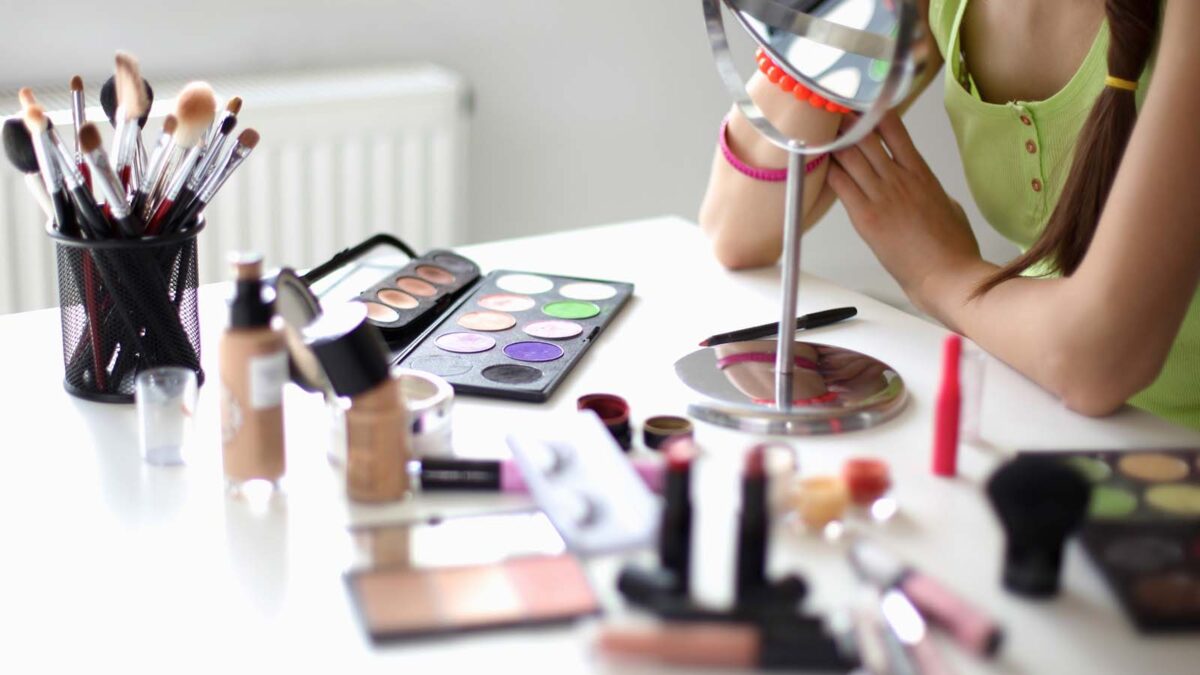
Detox Your Makeup Bag & Top Chemicals To Avoid In Makeup
This post contains affiliate links
This is usually one of the last product categories that my clients consider when switching to clean beauty. I’ve lost count of how many people tell me they still have an eye shadow or lipstick in their makeup kit from high school or college and that YES, they will use it on occasion! If this is you, it’s time to detox your makeup bag! If you have diligently updated your makeup bag, but tend to stick with whatever is cheapest and haven’t ever looked at the ingredient label, it’s time to detox your makeup bag! If you’ve been doing swaps here and there, but only base your swaps on what your favorite influencer is sharing, it’s time to detox your makeup bag and understand what is health-supportive versus what could be contributing to health issues.
It’s really important to consider your makeup, because, like skincare, it sits on your skin all day. Any product that stays on your skin – versus being washed off – can create a heavier chemical load on the body, especially when it contains some of the more harmful chemicals used in personal care and makeup today.
WHY DETOX:
- Makeup sits on your skin all day and can have either positive or negative health impacts.
- Color Cosmetics are highly prone to heavy metal contamination like lead and asbestos.
WHAT TO DETOX:
- Old and expired products
- Color Cosmetics that contain fragrances, parabens, etc. Not sure how yours rates? Check them out on EWG.org’s SkinDeep Database, I always like to ensure that my products rate below a 3, whenever possible. One of my favorite brands, Beautycounter, has chosen to have all their products EWG Verified, which means they’ve turned over all their data to a 3rd party so that the validity of the formulations goes beyond Beautycounter’s word for them and the 3rd party can verify that the products are what the company says they are.
- Beauty sponges or old brushes that no longer be cleaned properly, because they are perfect breeding grounds for bacteria and can contribute to acne breakouts, dry skin, and irritation.
WHEN TO TOSS OLD PRODUCTS:
• Mascara and liquid eyeliners: within 60-90 days of opening, because of bacteria growth.
• Liquid Foundations: within a year of opening because of oxidation and product integrity.
• Pressed Powders & Lip Glosses/LipSticks: about every 2-3 years
• Eye & Lip Pencils: 3+ years, because they can be sharpened and maintain their quality.
FUN FACT: did you know that the little symbol of an open cylinder with 9M, 12M, 24M, etc stands for how many months the product is good to use AFTER opening?

Some other maintenance tips.
- Wash your Powder makeup brushes at least 1x a month. More often for eye shadow brushes and foundation brushes, if they are used frequently. These should be washed 1x a week to every other week.
- Wipe off your eyelash curler with rubbing alcohol, and let dry, to sanitize.
- Empty contents of makeup bag and wipe clean with a damp cloth, a couple times a year, to keep brushes and compacts free is excess dust and debris.
INGREDIENT EXPLORATION
DID YOU KNOW?
The last time a federal law was passed regulating the beauty industry was in 1938.
1,400 Potentially harmful ingredients are banned from personal care products in Europe. Only 30 harmful chemicals have been banned in the U.S.
Considering what we learned above, the most important thing to know is that we are our own best advocates! Learning a few key things to watch for in the ingredient lists of your favorite go-to products will go a long way in helping you find the healthiest options possible. Don’t get overwhelmed, just start with one thing at a time. Progress over perfection always!
Parabens – Parabens are used in cosmetics as a preservative to prevent bacteria growth and increase shelf life. However, parabens are known endocrine disrupters and can mimic or disrupt estrogen in the body, contributing to hormone imbalances and cancer.
PEGs (polyethylene glycols) – Used in mascaras as emollients and emulsifiers, PEGs are petroleum compounds which help products absorb more deeply into the skin. Unfortunately, they are often contaminated with known carcinogens.
Heavy Metals– Color cosmetics get its colorants from the earth, which is where heavy metals are inherently found. This is why SOURCING and TESTING are so important. Heavy metals such as lead, aluminum, and chromium are incredibly toxic to the body. And you won’t find it in the ingredient list, because it’s not added on purpose but rather a byproduct that tags along.
Carbon Black – this is very commonly found in mascaras, eyeliners and eye pencils/gels. It’s linked to cancer and organ toxicity. Look for its other names: channel black, pigment black 6, pigment black 7, acetylene black, froflow, arogen, arotene, arovel, arrow, atlantic, and black pearls.
Phthalates– These are plasticizing chemicals which help lubricate other substances, help lotions and makeup penetrate and soften the skin, and help fragrances last longer. Phthalates have been linked to an array of troubling issues to include asthma, ADHD, breast cancer, obesity, type II diabetes, neurodevelopmental issues, behavioral issues, autism spectrum disorders, endocrine disruption, impaired reproductive development, and male fertility issues.
Petroleum/Petrolatum/Mineral Oils – This group of ingredient in their various forms are used to create a barrier to lock in moisture in a variety of moisturizers as well as being popular in hair care products for the sheen and shine they create. Petroleum, Petrolatum, and Mineral Oils can be contaminated with polycyclic aromatic hydrocarbons (PAHs). Studies suggest that exposure to PAHs — including skin contact over extended periods of time — is associated with cancer. On this basis, the European Union classifies petrolatum a carcinogen and restricts its use in cosmetics. PAHs in petrolatum can also cause skin irritation and allergies.
Polytetrafluoroethylene (PTFE, Aka Teflon®) – Yes, Teflon® in your makeup! Blech! This non-stick ingredient and other fluorinated compounds have been linked to delayed menstruation, breast development and a variety of cancers. Typically found in pressed powders, bronzers, blushes, mascara, lip balms, anti-agings lotions, etc.
WHAT CAN YOU DO?
- WATCH for the word “FRAGRANCE” in any ingredient label. It’s completely legal for companies to hide hundreds of known toxic chemicals behind that one word, creating a chemical cocktail of “proprietary” components that protect them from ever needing to disclose the exact chemicals being used. Chemicals that are known carcinogens, known hormone & endocrine disruptors and known allergens & irritants. Watch for this in ingredient labels when shopping and it will dramatically narrow down your options. From there begin shopping brands that are choosing the most health protective formulations for their products possible, such as Beautycounter.
- Get EWG’s FREE Healthy Living App and start scanning your products for safety on the go, as you shop. Then as you run out of products, start switching to safer products that don’t contain hormone disruptors, carcinogens and allergens. *WHAT IS EWG? The Environmental Working Group is a non-profit organization dedicated to protecting human health and the environment. Their ratings look at proved research in the areas of Hormonal Disruption (Endocrine), Carcinogens and Allergens & Irritants. Their ratings are on a scale of 1-10 (1being the BEST, 10 being WORST).
- Text “BetterBeauty” to 52886 to urge Congress to pass more health-protective laws for the personal-care industry.
Additional resource center to learn more: safecosmetics.org
Need more personalized support and guidance?

![In our summer era☀️
What’s your favorite slow summer activity?
[mom influencer, deliberate mom, viral reel, clean living, intentional summertime, explore page, for you page, real motherhood, boy mom, girl mom, life with kids, parenthood, mom life, motherhood]](https://cleanbecky.com/wp-content/uploads/2024/05/508385984_18515454589042139_760553952526085181_n-320x320.webp)




